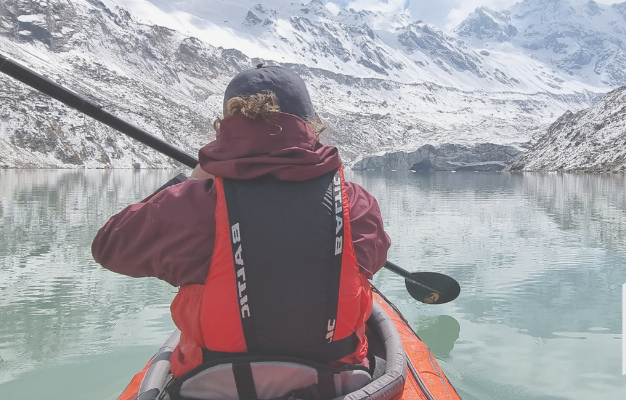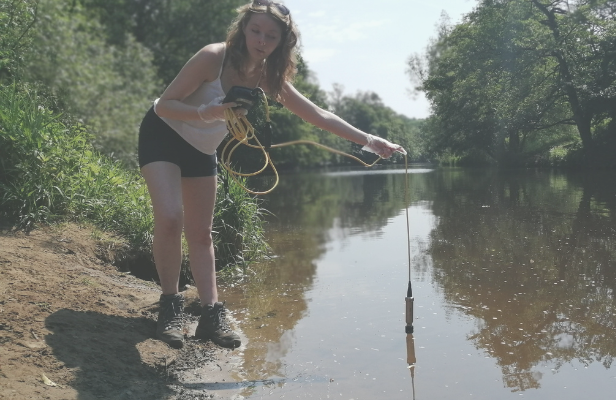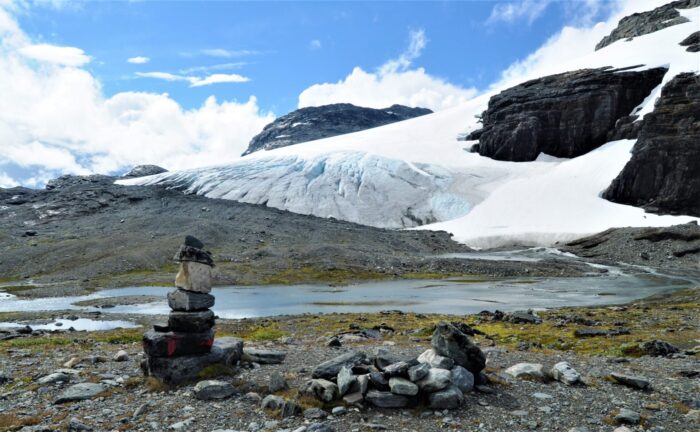From running rivers to retreating glaciers

To mark World Water Week 2023, we are highlighting the work of water@leeds across the faculties of the University. This article focuses on water research from the Faculty of Environment.
Water is the life source of our planet: our bodies, plants and oceans are made of it. Without it, or when it’s poorly managed, there can be disastrous effects on the planet, human and animal health.
However, it’s a complex picture with lots of aspects to consider, such as ocean health, marine life, freshwater quality, ice sheets, glaciers, drought, flooding, water infrastructure and more.
At the University, we have over 300 researchers working on water-related projects across all faculties supported by water@leeds.
This article focuses on the research in the Faculty of Environment to support better understanding and management of water.
River testing
Freshwaters, such as in rivers and lakes, are essential to life in many ways.
However, they are increasingly polluted and mistreated. This has led local communities to seek help to understand and improve the quality of their rivers.
In Yorkshire, a group of researchers with water@leeds are supporting the local communities of Knaresborough and Gledhow Valley to test their river quality.
Maddy Wright, who is a Masters student in the School of Geography, helped the community by testing the waters for temperature, oxygen, PH, electrical conductivity, E. Coli, nutrients and dissolved organic matter.

Maddy and colleagues Professor Paul Kay and Dr Paul Hutchings were also able to pinpoint the source of some of the issues that the river was facing.
In the places they tested, for example, they identified that agricultural run-off was the cause of the presence of E. Coli.
They shared their knowledge at community events, allowing the public to make decisions about how to manage the river.
They’ve begun training the community at Gledhow Valley to test their own water, giving them advice on equipment, testing locations and how to interpret the results.
Maddy hopes that creating self-sufficient groups will help build a bigger picture of river quality data.
The team have plans to create a Yorkshire-wide database that’s accessible to everyone.
Maddy says, “I’m grateful that there’s a community who actively want to participate in this research.
There are a range of issues facing the quality of water in the UK and we need to face all of them. As well as sewage and agriculture, how we consume and what we put down our drains make a difference.
“Our data builds a more open picture about our water quality and how we can improve it.”
This is part of ongoing work at the University to understand and improve freshwater quality.
Freshwater Quality Champions
In 2022, two academics were appointed Freshwater Quality Champions by the Natural Environment Research Council (NERC).
This was the beginning of a four-year programme to study the water quality in UK rivers, titled ‘Understanding changes in quality of UK freshwaters’.
The Freshwater Quality Champions at Leeds are Professor Pippa Chapman and Professor Joseph Holden.
Their joint statement said they aim to “build an interdisciplinary freshwater quality community that includes researchers, practitioners and policymakers, capable of delivering impactful, transformative research to understand the major sources, pathways, transformations and interactions of pollutants in freshwater ecosystems.”
Read more about the Freshwater Quality Champions.
Impacts of Glacier Retreat
Running freshwater is essential, but the majority of “freshwater” on the planet is contained within ice such as glaciers.
Due to climate change, glaciers all over the world are melting and retreating.
Experts have already accepted a certain amount of loss, but pulling back on emissions and working towards net zero would resolve the situation for the remaining ice.
This action is needed urgently: in a recent project which measured the temperature of the Khumbu Glacier on Everest, Nepal, the research team found that over half of the lower glacier was at the melting point.
Researchers belonging to the group GLIMR: Global Impacts of Glacier Retreat are investigating the varied effects of glacier retreat, from biodiversity loss to increased flooding.
Professor Lee Brown and Professor Jonathan Carrivick found that when glaciers move, insects living there must adapt to warmer water or migrate to other areas. As the bottom layer of the food chain, this affects the entire ecosystem.
This work reflects the need for flexible protection in areas where habitats are moving – wildlife may move out of protected areas due to habitat or food source loss.
Glacier retreat effects on local populations
As glaciers melt, they create lakes that are trapped at high elevations. These lakes have the potential to breach dams and create huge flooding events.
Professor Carrivick has used satellite imaging and geographic information systems (GIS) to measure glacial lakes and track their growth.
This will mean flood risk can be predicted and managed more easily.

Glacier retreat affects local populations and communities most of all. As well as the risk of flooding by glacial lakes, the way that they use the glacial water will be forced to adapt.
Many communities use the water that runs from glaciers to use for their agriculture and infrastructure.
Professor Duncan Quincey has used numerical modelling and satellite data to project their future landscapes.
Professor Quincey and the team have visited communities in high-mountain areas such as the Himalayas and the Andes and used VR technology to communicate what the future of their local landscapes could be.
I want to highlight the frozen state of water, which is on the cusp of disappearing. We’re dependent on this for water supply in downstream areas; the frozen state represents our future
Some projects have sought to protect ice by covering it in blankets, while in Northern India, a project has begun to grow glaciers or “ice stupas” by spraying and freezing water vapour onto metal pipes.
Although these projects show positive effects for the local communities, unfortunately, they aren’t practical solutions across mountain ranges, let alone worldwide.
The best and most effective goal is to halt glacier loss and protect the ice that is still there. For that to happen, there needs to be a radical change in global emissions, as repeatedly called for at recent UN Climate Conferences.
More information
As well as the research into fresh and frozen water, researchers from the Faculty of Environment collaborate across disciplines and industries to deliver projects that support better water management.
Find out more:
